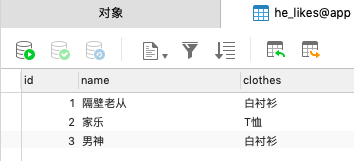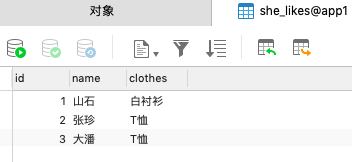JHipster微服务(uaa、app、gateway),下图注册中心中app和app1均为微服务(MicroService)且gateway基于uaa。

服务调用:
如上图注册中心所示,多个微服务进行了服务注册,那么当app应用需要app1中的数据(或者app1需要app当中的数据)时该如何调用呢?
解决办法如下:
以下是在app1中操作,app以及别的微服务调用都是同一个套路。
第一步:在client目录下新建Client请求的接口
@AuthorizedFeignClient(name = “app”)
注意:name写你要调用的微服务在注册中心中的注册名。
@RequestMapping(method = RequestMethod.GET, value = “/api/app/appString”)
注意:method 指请求方式,value写你请求微服务资源的路径。
接口中的方法返回类型和你调用返出来数据类型一致就ok。
package com.mycompany.myapp.client;
import com.mycompany.myapp.web.rest.vm.HeLikes;
import org.springframework.web.bind.annotation.RequestMapping;
import org.springframework.web.bind.annotation.RequestMethod;
import java.util.List;
/**
* @author [email protected]
* @version 1.0
* @date 2019-08-26 09:53
*/
@AuthorizedFeignClient(name = "app")
public interface RequestAppClient {
@RequestMapping(method = RequestMethod.GET, value = "/api/app/appString")
public String getAppString();
@RequestMapping(method = RequestMethod.GET, value = "/api/app/appList")
public List<HeLikes> getAppList();
}
第二步:在web.rest.vm下创建你接收数据的接收类。
注意:这个类要和你服务调用时返回实体类一致。比如:服务A调用服务B中方法(List getAllStudents)那么,这个接收类就要定义为Student并且属性值一致。
对于这个接收类,我尝试过使用lombok,添加@Data注解后出现了一方可用,一方不可用的情况(getter setter方法可以调出来,但是赋值时提示找不到)
解决办法:1、手动添加getter setter方法 。 2、直接把那个实体类copy过来。
package com.mycompany.myapp.web.rest.vm;
import org.hibernate.annotations.Cache;
import org.hibernate.annotations.CacheConcurrencyStrategy;
import javax.persistence.*;
import java.io.Serializable;
/**
* A HeLikes.
*/
@Entity
@Table(name = "he_likes")
@Cache(usage = CacheConcurrencyStrategy.NONSTRICT_READ_WRITE)
public class HeLikes implements Serializable {
private static final long serialVersionUID = 1L;
@Id
@GeneratedValue(strategy = GenerationType.IDENTITY)
private Long id;
@Column(name = "name")
private String name;
@Column(name = "clothes")
private String clothes;
// jhipster-needle-entity-add-field - JHipster will add fields here, do not remove
public Long getId() {
return id;
}
public void setId(Long id) {
this.id = id;
}
public String getName() {
return name;
}
public HeLikes name(String name) {
this.name = name;
return this;
}
public void setName(String name) {
this.name = name;
}
public String getClothes() {
return clothes;
}
public HeLikes clothes(String clothes) {
this.clothes = clothes;
return this;
}
public void setClothes(String clothes) {
this.clothes = clothes;
}
// jhipster-needle-entity-add-getters-setters - JHipster will add getters and setters here, do not remove
@Override
public boolean equals(Object o) {
if (this == o) {
return true;
}
if (!(o instanceof HeLikes)) {
return false;
}
return id != null && id.equals(((HeLikes) o).id);
}
@Override
public int hashCode() {
return 31;
}
@Override
public String toString() {
return "HeLikes{" +
"id=" + getId() +
", name='" + getName() + "'" +
", clothes='" + getClothes() + "'" +
"}";
}
}
第三步:在controller中调用自定义client中目标资源的方法。
package com.mycompany.myapp.web.rest;
import com.mycompany.myapp.client.RequestAppClient;
import com.mycompany.myapp.domain.SheLikes;
import com.mycompany.myapp.service.impl.SheLikesServiceImpl;
import com.mycompany.myapp.web.rest.vm.HeLikes;
import io.micrometer.core.annotation.Timed;
import org.springframework.beans.factory.annotation.Autowired;
import org.springframework.web.bind.annotation.GetMapping;
import org.springframework.web.bind.annotation.RequestMapping;
import org.springframework.web.bind.annotation.RestController;
import java.util.List;
/**
* @author [email protected]
* @version 1.0
* @date 2019-08-26 10:04
*/
@RestController
@RequestMapping("/api/app1")
public class RequestController {
@Autowired
private SheLikesServiceImpl sheLikesService;
private final RequestAppClient client;
public RequestController(RequestAppClient client) {
this.client = client;
}
/**
* 服务调用方法,返回字符串
* @return
*/
@GetMapping("/appString")
@Timed
public String getString() {
return client.getAppString();
}
/**
* 自己调用的方法
* @return
*/
@GetMapping("/app1String")
@Timed
public String getSelfString() {
return "我是app1";
}
/**
* 服务调用的方法,返回list
* @return
*/
@GetMapping("/appList")
@Timed
public List<HeLikes> getFromApp() {
return client.getAppList();
}
/**
* 自己调用的方法,返回list
* @return
*/
@GetMapping("/app1List")
@Timed
public List<SheLikes> getApp1List() {
return sheLikesService.getAllSheLikes();
}
}
app的RequestController
package com.mycompany.myapp.web.rest;
import com.mycompany.myapp.client.RequestApp1Client;
import com.mycompany.myapp.domain.HeLikes;
import com.mycompany.myapp.security.AuthoritiesConstants;
import com.mycompany.myapp.service.impl.HeLikesServiceImpl;
import com.mycompany.myapp.web.rest.vm.SheLikes;
import io.micrometer.core.annotation.Timed;
import org.springframework.beans.factory.annotation.Autowired;
import org.springframework.security.access.prepost.PreAuthorize;
import org.springframework.web.bind.annotation.GetMapping;
import org.springframework.web.bind.annotation.RequestMapping;
import org.springframework.web.bind.annotation.RestController;
import java.util.List;
/**
* @author [email protected]
* @version 1.0
* @date 2019-08-26 10:22
*/
@RestController
@RequestMapping("/api/app")
public class RequestController {
private final RequestApp1Client client;
@Autowired
private HeLikesServiceImpl heLikesService;
public RequestController(RequestApp1Client client) {
this.client = client;
}
@GetMapping("/appString")
@Timed
public String getString() {
return "我是app";
}
// APP实体数据
@GetMapping("/appList")
@Timed
public List<HeLikes> getAppList() {
return heLikesService.getAllHeLikes();
}
@GetMapping("/app1String")
@Timed
public String getApp1String() {
return client.getApp1String();
}
@GetMapping("/app1List")
@Timed
// 单个权限
// @PreAuthorize("hasRole('ROLE_USER')")
// 多个权限
@PreAuthorize("hasRole(\"" + AuthoritiesConstants.ADMIN + "\")or hasRole(\"" + AuthoritiesConstants.USER + "\") ")
public List<SheLikes> getApp1List() {
return client.getApp1List();
}
}
数据库中数据如下
- app

- app1

swagger测试
- 调用自身方法:

- 服务调用,调用app中方法:


权限验证:
@GetMapping("/app1-list")
@Timed
// 单个权限
// @PreAuthorize("hasRole('ROLE_USER')")
// 多个权限
// @PreAuthorize("hasAnyRole('ROLE_ADMIN,ROLE_USER')")
@PreAuthorize("hasRole(\"" + AuthoritiesConstants.ADMIN + "\")or hasRole(\"" + AuthoritiesConstants.USER + "\") ")
public List<SheLikes> getApp1List() {
return client.getApp1List();
}
- 无权限的

- 有权限的

总结:
个人感觉,相互调用本质上就是在自己的controller中定义一个方法,指定一个路由,该方法中调用client中自定义的方法,而在你接口上方又指定了RequestMapping的路径,通过@AuthorizedFeignClient找到注册中心具体的某个服务,然后调用,返回数据。
